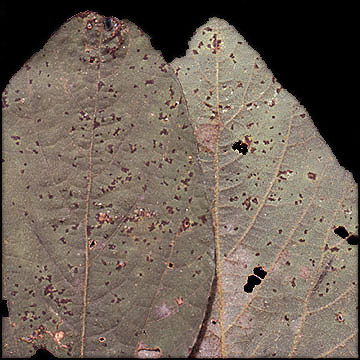Bacterial pustule
Xanthomonas axonopodia pv. glycines
 Upper and lower leaf surface
Upper and lower leaf surface
Upper leaf surface symptoms
Bacterial pustule lesions begin as small, light green lesions. Older lesions may be darker and range from small spots to large areas of dead tissue formed when smaller lesions merge. The water soaking common to bacterial blight is seldom seen with bacterial pustule. Initially the center of the lesion may be slightly raised.
Lower leaf surface symptoms
The raised center or "pustule" may be more evident in lesions on the lower leaf surface and might be mistaken for soybean rust pustules. Bacterial pustules do not produce spores; viewed under magnification, they may show cracking or fissures rather than the circular openings characteristic of soybean rust.
Canopy symptoms
The bacteria that cause bacterial pustule are spread by wind-driven rain. Outbreaks typically develop several days after a rainstorm or hailstorm. Symptoms are most evident on growth that is expanding at the time of the rain event.
Weather
Bacterial pustule is favored by wet or rainy weather. Disease outbreaks usually occur 5 to 7 days after wind-driven rains. Bacterial pustule is not slowed by high temperatures, as is bacterial blight.
Survival
The bacterial pustule pathogen survives in infested residues left on the soil surface and may be seedborne.
Distribution in Missouri
Bacterial pustule may occur throughout the state. However, there had been few reports of bacterial pustule occurring anywhere in Missouri over the last 5-10 years — until the 2004 season. The unusually wet conditions of the 2004 season and the number of major hailstorms in the state led to the occurrence of bacterial pustule in many regions of Missouri.